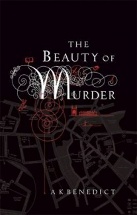The beauty of murder by A. K. Benedict

Orion, 2013. ISBN 9781409144526
(Age: 14+) Recommended. Crime. University. When Dr. Stephen Killigan
takes up his appointment at Sepulchre College, Cambridge, his life
changes in some unexpected ways. Heavily tattooed Stephen doesn't
fit most people's image of a Cambridge don, which may affect the way
he's perceived.
After consuming a number of drinks with a friend and colleague
Stephen goes out for kebabs and discovers a masked body in a church
yard. He has to move off to get a signal for his mobile phone and
when he returns with the police the body is gone, as is any evidence
of any foul play. The police, in the form of Inspector Jane Horne,
are not well pleased.
The body of a young boy is found within the university with a
similar mask to one Killigan described on the church yard body. This
all leads to him being a suspect and his reputation in Sepulchre
College and in Cambridge becoming very dodgy. He ends up plunging
into the Cam letting the water take him, when he is rescued by
someone from a different time.
It is no mean feat to construct a time travel tale that is
believable, but Benedict does it superbly. Her historical knowledge
and interaction of her cast of characters allows the reader to be
carried away to wherever she wishes. It is through the travelling
that Stephen meets Jackamore Grass, discovers his relationships with
the present and the past and his addiction to murder. With the help
of Lana Carver, who works in the library and the wonderful Professor
Iris Burton, the eccentric elderly academic whose beliefs have led to
her gaining a rather dubious reputation, he is able to sort out fact
from fiction and convince Horne that he is not a lunatic.
Benedict has created a wonderful concoction, part fantasy, part
historical novel, part thriller and finally a murder mystery. Along
the way she has finely drawn and observed an intriguing group of
people, all interesting in their own right. A thoroughly enjoyable
read. Highly recommended for an adult audience and mature secondary
students.
Mark Knight